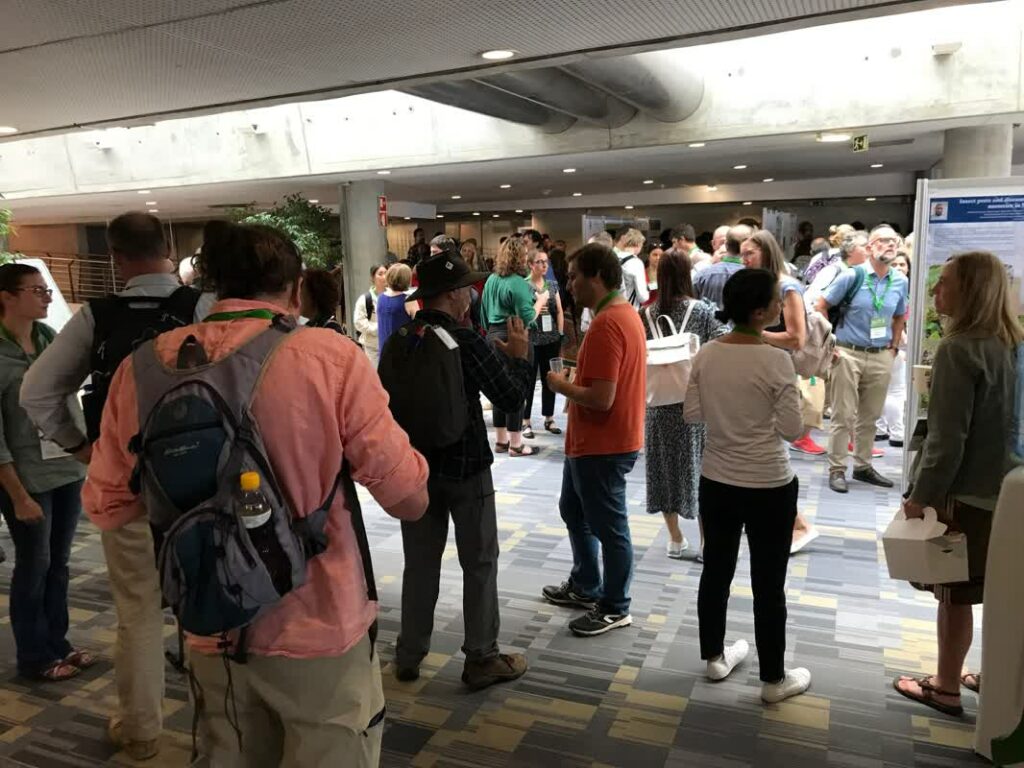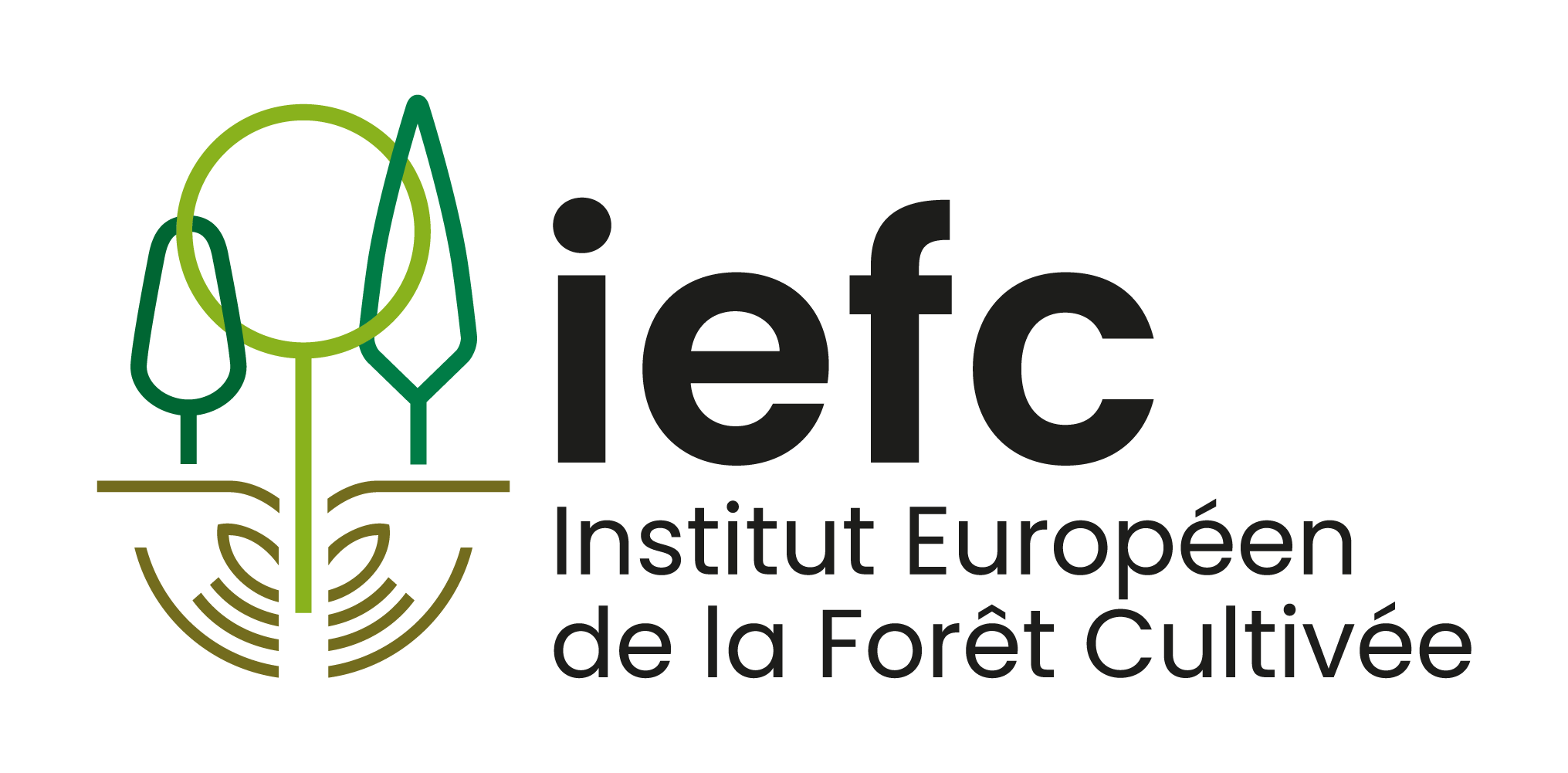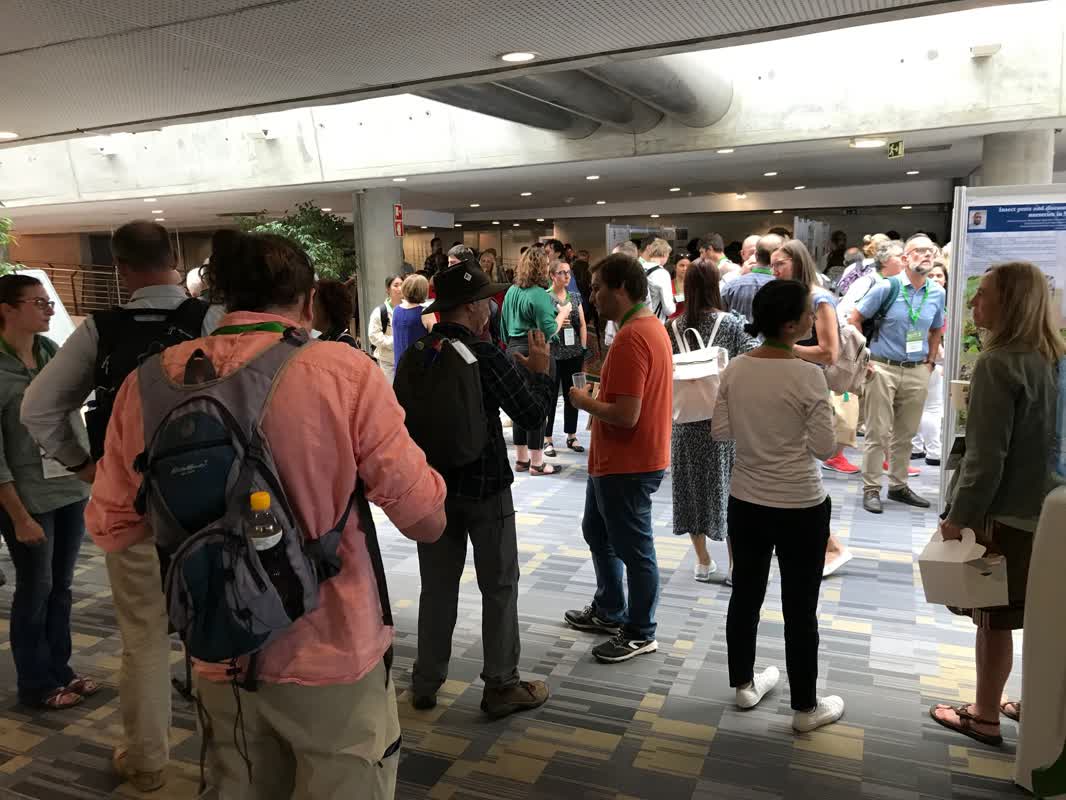
The IUFRO Division 7 (Forest Health. Pathology and Entomology) Conference took place in Lisbon from the 6th to 9th September 2022, with 350 participants present (and 60 remote participants) from 41 countries.
The session on Pine Wilt Disease (PWD,) organized within this meeting, had a massive participation in 3 sub-sessions involving 14 oral presentations and 15 posters.
Four major themes were addressed:
1. PWD history and survey
More than 100 years have passed since Pine Wilt Disease (PWD), caused by the Pinewood nematode (PWN – Bursaphelenchus xylophilus) invaded Japan, first occurring in the south-western region, and later spread throughout the country reaching the cooler climate high-latitude and high-elevation regions. Native pine trees (Pinus thunbergii and P. densiflora) are nearly exterminated in some of the old-damaged areas. In some locations, where pine forest is economically important for the timber industry or mushroom production, regeneration is difficult. Moreover, pine trees are an essential component in wind and sand-break forests in the coastal area, as well as to the traditional scenery of Japan.
In Korea, more than thirty years have passed since PWD was first detected in a small number of infected pine trees, in a small mountain in Busan, in 1988., in 2022, the PWD was reported from 135 districts, counties and cities. The number of infected pine trees (mainly P. thunbergii and P. densiflora) has fluctuated during 30 years, surpassing 2 million trees in 2014. Recently, it had decreased to 390,000 in 2021, but in the last control season , the number of infected pine trees increased again, by 22.6% compared to previous year. the years, PWD research and survey techniques have developed considerably over the years. NFC electronic tags are used for monitoring blind spots, and a QR code system was implemented to record the presence of the nematode in dead pine trees , allowing to check in real time the information inputted, and record the management process. The genome sequencing of the population of Korean pinewood nematodes showed an extremely stratified population structure, mainly composed of two major lineages within which the genetic diversity is extremely limited that seem to indicate independent introductions.
In 1999 the PWN was detected in Portugal on maritime pine (Pinus pinaster) and on the following 20 years, thousands of maritime pine trees were annually cut, in spite of the efforts implemented by the Portuguese Forest Authority (ICNF), following the guidelines of the European Commission Implementing Decision 2012/535/EU, in order to contain its spread. Over the last 11 years more than 83,500 wood composite samples were analyzed from symptomatic trees, with an average of 8% PWN positive results, none originating from the Buffer Zone (20 km along the Spanish border). As a consequence of the containment actions, close to 18 million declining trees were felled in the mainland territory, especially in the Buffer Zone (2.9 million), and around 43 million insect-vectors were caught in the traps. A new focus was detected in Madeira Island in 2009 and, in Spain, the PWD was first detected in October 2008 and declared eradicated in 2013, although subsequently, five other outbreaks were reported in Caceres, As Neves, Valverde del Fresno, Sancti-Spiritus and Lagunilla (at about 70 km, the furthest from the Portuguese border).
In North America, where the PWN is native causing minor damage to native conifers, it was detected initially in longleaf pine (Pinus palustris) timber, in Louisiana,. Over the past ten years, due to stricter regulations on PWN, a large number of pine wood samples have been analyzed at the Agronomic Division of the North Carolina Department of Agriculture & Consumer Services. Between 2012 and 2022, 67,135 pine wood samples were analyzed, and 7,462 reports were generated in connection with the issuance of phytosanitary certificates by USDA/APHIS/PPQ for export of pine wood logs. Small amounts of the PWD were detected in 2,15% of the samples.
The detection of the PWN in wood samples is made using, the Baermann method (funnel or modified) for recommended periods of 24 or 48 hours (Schroder et al., 2009; ISPM 27, 2016). In one of the studies presented, the 24h exposure to temperatures of 25ºC allowed to extract 80% of the nematodes in sample.
2. PWD dynamics and spread
Recently, the tree mortality of USA native pine t((P. ponderosa) in Colorado was associated with PWN reported from the Front Range of. Over the past years, sampling to survey for the PWN in native pine (Pinus ponderosa) and the collection of trapped longhorn beetles (Monochamus clamator and M. scutellatus) across natural and urban forest landscapes alloed determining the insect flight period and the PWN was found in 3.6% and 4.2% of sampled pines and beetles, respectively. This was the first report of M. clamator–PWN association in the United States.
Until very recently, it was assumed that, under Portuguese climatic conditions, trees would show symptoms in the same year of the nematodes’ inoculation by the vector. However, some uncertainty remained related to the likelihood of latency of the pine wilt. To assess the the latency occurrence a mathematical model (ETpN) was developed allowing the identification of 3 sub-regions in Portugal: “No wilt expected”, “Latency (wilt expected in the year following the infestation)” or “Wilt expression in the year of inoculation”.
A field trial was established with plots located in pine stands form the 3 different sub-regions. Each month, from June until November, 5 healthy trees were inoculated at each selected location, with 10.000 Bx, using Arbojet Quick-Jet kit, in the lower part of the canopy. Two weeks after the first visual wilting symptoms, the trees were felled and sampled for the presence of the PWN. At the end of the experimental period, all the remaining trees were also felled and sampled for the PWN. Latency was in fact observed in the sub-region where it was expected but also in the “No wilt expected” sub-region where the wilt occurred in the year of infestation.
Since the disease dispersal depends on the flight range of the vector insects it is important to study the flight distance, period, and velocity in order to define protective measures. Thus, two vector species in Korea, M. saltuarius and M. alternatus adults, were studied using flight mills. In M. saltuarius, the average flight distance of females in a single flight session was 0.43 km, while males flew about 0.50 km. The average cumulated flight distances for entire life span in females and males were 1.93 km (maximum flight distance: 5.21 km) and 2.71 km (maximum flight distance: 5.73 km), respectively. In M. alternatus, the average flight distance of females in a single flight session was 1.53 km, while males flew about 2.05 km. The average cumulated flight distances for entire life span in females and males were 6.64 km (maximum flight distance: 15.35 km) and 9.89 km (maximum flight distance: 29.01 km), respectively.
Considering the vectorinsect-high flying ability, the PWD spread in natural conditions was assessed in Portugal along a 6 km long, and 100 m wide transect in a continuous P. pinaster stand, starting at the location of one PWN infected tree detected in 2018, in a previously non-affected parish. In 2019 and 2020, from May until October, 30 multi-funnel traps with Galloprotect 2D-plus lures were placed in-paired, along the transect every 50 m. All vector-insect (M. galloprovincialis) caught were quantified and assessed for the PWN presence. In winter of 2020 and 2021, the transect was intensively surveyed and all symptomatic trees were felled and sampled. In the 2020 survey, out of the 65 trees sampled only two, located in the surroundings of the initial infection spot (less than 100 m) were infected with the PWN. However, in the 2021 survey, the number of dead or symptomatic pine trees increased to 104 with ten infected with the PWN and found near the end of the transect. Moreover, the PWN was found in 35 of the 510 vector-insects- caught in the traps during summer 2020, with four infected beetles on the traps further away from the initial infection spot. Within one year, the vector-insects rapidly spread along the 6 kms’ transect, some of them carrying PWN (6.4%) and consequently spreading the disease throughout the whole area.
Another study related to the dispersal of the vector-insect M. galloprovincialis was carried out in France analyzing population genetic connectivity to quantify contemporary dispersal in parentage using beetles collected in baited traps, in a maritime pine homogeneous landscape of and in a heterogeneous landscape of mixed broadleaved and pine stands,. Almost all of the displacement occurred between geographical sectors, suggesting long distance dispersal.
3. Interactions between Host-PWN-Other micro-organisms
The PWN uses its stylet to perforate cell walls and to release hydrolytic enzymes against cell wall glycans. More susceptible (P. pinaster) and less susceptible (P. pinea) species were inoculated with the PWN and the disease progression was monitored under controlled temperatures and soil water contents. At the end of the assays, differences in the nematode reproduction were found on both species. High-throughput vibrational spectroscopy techniques were applied for a global cell-walls’ characterization. Preliminary data revealed that there are significantly different cell-walls compositional properties between PWN-inoculated and control P. pinaster samples, where phenolic compounds are upregulated in PWN-inoculated plants, presumably as a defense response mechanisms against inoculation.
The interspecific interaction between the nematode and its symbiotic partners seems to play a role in promoting pathogenicity and invasiveness of the PWN. Chemical and molecular signals positively influence survival, reproduction and spread of the PWN. On the other hand, the characterization of the structure and dynamics of the nematode-fungi interactions (using culturable and non-culturable approaches with special emphasis in metagenomics analyses) may allow to understanding if PWN-associated mycobiota plays a key-role in the development of PWD, and to which extend can it be used to disrupt the disease cycle. The diversity and structure of the fungal communities in P. pinaster varied as the disease progresses s suggesting that the PWN presence affects the endophytic fungal communities. For both P. pinaster and PWN fungal communities, differences were also found with the Ophiostomatales being detected only in PWN-infected P. pinaster trees, corroborating our culturomics results previously obtained.
4. Control methods and management strategies
The clear-cut strategy usually implemented after first detection in PWN-free areas was compared with an alternative tree-by-tree selective cutting combined with increased surveillance, and the last revealed to be a better choice to control PWN in terms of cost-effectiveness.
In Japan, the PWD control mainly consists of the destruction of infected trees combined with the preventive spraying with insecticide and trunk injection of nematicide on healthy trees with enormous costs and constrains to pesticide use. Thus, seedlings of resistant clones are commonly being used in new pine plantations.
The susceptibility of different P. pinaster provenances (Spanish, Portuguese, French and Marocco) were tested for B. xylophilus susceptibility in two seed orchards, one belonging to the Galician P. pinaster breeding program in Spain and the other to the Landes, in France. Significant differences in survival, wilting symptoms, morphological traits and density of nematode populations were found among provenances and seed orchards. A geographic pattern was found with the provenances from the south-east of the Iberian Peninsula showing the highest resistance to PWD.
The efficacy of sixteen locally produced formulations of emamectin benzoate (EB) against the PWN were compared in Korea. At high concentrations of 0.258 μg/ml, nematode reproduction was highly suppressed, although substantial variations in sublethal toxicities, which can be related to the inert ingredients used by the producers, were found.
Although highly effective, chemical control commonly resorts to the use of highly damaging synthetic chemicals with adverse effects on forest ecosystems and human health. a significant effort has been made to develop a more sustainable chemical management of the PWN based on the volatiles and volatile extracts from natural sources, mainly plants and fungi.. Essential oils are complex mixtures of plant volatiles, mainly extracted through hydro distillation from medicinal and aromatic plant species, and may prove to be toxic to the PWN and safe to the pine host with low environmental impact. Undecanoic acid showed a stronger activity reaching a half maximal effective concentration (EC50) of 0.06 μg/mL, while decanoic acid showed a higher EC50, namely 0.13 μg/mL Future research will determine the activity of other medium chain fatty acids as potential biopesticidal molecules to be used in sustainable pest management strategies.
The search for antagonists is also increasing, and in laboratory assays carried out in Portugal, the nematophagous fungi Esteya vermicola and E. floridanum revealed to be a promising biocontrol agent against the PWN. In fact, the protective effects of E. vermicola coreana (G810) inoculations on the large pine trees of Mt. Wora, South Korea, , and in Kwangdong province in China, were evaluated revealing survival rates of 50% and 60%, respectively.
In Spain, eight fungal species with nematophagous potential were tested in vitro, where the Beauveria species (B. bassiana and B. pseudobassiana) and Trichoderma citrinoviridae not only prevented PWN reproduction but also showed nematicidal effect.
Luís Bonifácio & Edmundo Sousa
Instituto Nacional de Investigação Agrária e Veterinária, I.P. (INIAV), Av. da República, Quinta do Marquês, 2780-157 Oeiras, Portugal. Luis.bonifacio@iniav.pt; GREEN-IT Bioresources for Sustainability, ITQB NOVA, Av. da República, 2780-157 Oeiras, Portugal
Luís Bonifácio is the coordinator of IUFRO (international Union of Forest Research Organizations) working party on the Pine Wilt Disease (7.02.10).
https://www.iufro.org/science/divisions/division-7/70000/70200/70210/

